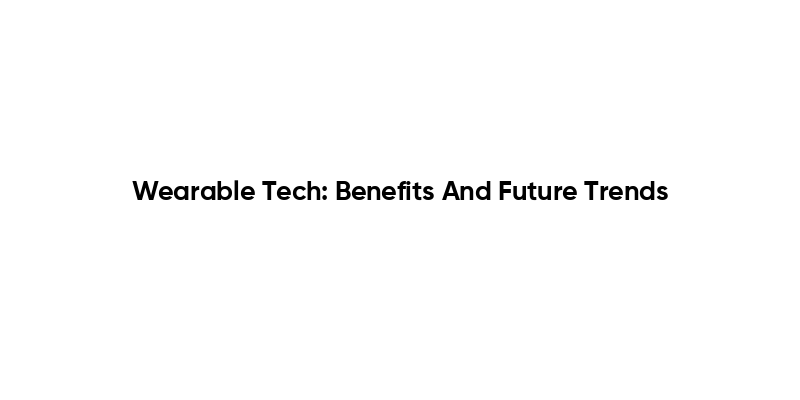In recent years, wearable technology has emerged as a revolutionary force in the tech landscape, offering a myriad of benefits that enhance our daily lives. From smartwatches to fitness trackers, these devices are not just gadgets; they are powerful tools that provide real-time data and insights into our health and well-being. As we delve into the world of wearable tech, we will explore its numerous advantages, including improved health monitoring, increased productivity, and enhanced connectivity. Understanding these benefits is crucial as we navigate the future of technology.
As you continue reading, you will discover how wearable technology is reshaping various industries, particularly healthcare and fitness. We will examine the latest innovations that are making waves in the market, such as advanced biometric sensors and AI-driven applications. Additionally, we will discuss the potential challenges and ethical considerations that come with the widespread adoption of wearables. By the end of this article, you will have a comprehensive understanding of the current trends and future possibilities in wearable technology.
Join us on this exciting journey as we uncover the transformative power of wearable tech. Whether you are a tech enthusiast, a health-conscious individual, or simply curious about the future of technology, this article promises to provide valuable insights and inspire you to embrace the wearables revolution. Don’t miss out on the opportunity to learn how these innovative devices can enhance your life and what the future holds for this dynamic field.
Wearable technology has rapidly evolved over the past decade, transforming the way we interact with our devices and manage our health. This article explores the benefits and future trends of wearable tech, highlighting its impact on various aspects of our lives.
Health Monitoring and Fitness Tracking
One of the most significant benefits of wearable technology is its ability to monitor health and fitness. Devices such as smartwatches and fitness trackers can track heart rate, sleep patterns, and physical activity levels. This data empowers users to make informed decisions about their health and fitness routines, leading to improved overall well-being.
Moreover, the integration of advanced sensors in wearable devices allows for real-time health monitoring. For instance, continuous glucose monitors provide vital information for diabetic patients, enabling them to manage their condition more effectively. As technology advances, we can expect even more sophisticated health monitoring features, making wearables an essential tool for personal health management.
Enhanced Connectivity and Communication
Wearable technology also enhances connectivity and communication. Smartwatches and fitness bands allow users to receive notifications, answer calls, and send messages directly from their wrists. This convenience reduces the need to constantly check smartphones, promoting a more seamless and efficient communication experience.
As wearable tech continues to evolve, we can anticipate the integration of more advanced communication features, such as voice assistants and augmented reality capabilities. These innovations will further enhance user interaction and connectivity, making wearables an integral part of our daily lives.
Impact on Healthcare and Telemedicine
The rise of wearable technology is significantly impacting the healthcare industry, particularly in the realm of telemedicine. Wearable devices enable remote patient monitoring, allowing healthcare providers to track patients’ vital signs and health metrics from a distance. This capability is especially beneficial for managing chronic conditions and providing timely interventions.
Additionally, the data collected from wearables can be used for research and development in healthcare. By analyzing large datasets, researchers can identify trends and patterns that contribute to better treatment options and preventive measures. As telemedicine continues to grow, wearables will play a crucial role in enhancing patient care and accessibility.
Future Trends in Wearable Technology
Looking ahead, several trends are expected to shape the future of wearable technology. One notable trend is the increasing focus on health and wellness, with devices becoming more specialized for specific health conditions. For example, wearables designed for mental health monitoring are gaining traction, providing users with insights into their emotional well-being.
Another trend is the integration of artificial intelligence (AI) in wearable devices. AI can analyze user data to provide personalized recommendations and insights, enhancing the overall user experience. As these technologies converge, we can expect wearables to become even more intuitive and responsive to individual needs.
Challenges and Considerations
Despite the numerous benefits of wearable technology, there are challenges and considerations to address. Privacy and data security are significant concerns, as wearables collect sensitive health information. Ensuring that user data is protected and used responsibly is crucial for maintaining trust in these devices.
Additionally, the accuracy of health data collected by wearables can vary, leading to potential misinterpretations. Users must be educated on the limitations of these devices and encouraged to consult healthcare professionals for critical health decisions. Addressing these challenges will be essential for the continued growth and acceptance of wearable technology.
| Aspect | Description |
|---|---|
| Definition | Wearable technology refers to electronic devices that can be worn on the body, often incorporating sensors and software to collect data and provide insights. |
| Benefits |
|
| Current Trends |
|
| Future Trends |
|



